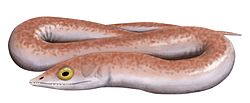Limbless vertebrate
 From Wikipedia - Reading time: 5 min
From Wikipedia - Reading time: 5 min
Many vertebrates are limbless, limb-reduced, or apodous, with a body plan consisting of a head and vertebral column, but no adjoining limbs such as legs or fins. Jawless fish are limbless but may have preceded the evolution of vertebrate limbs, whereas numerous reptile and amphibian lineages – and some eels and eel-like fish – independently lost their limbs. Larval amphibians, tadpoles, are also often limbless. No mammals or birds are limbless, but some feature partial limb-loss or limb reduction.
Examples
[edit]

The jawless fish (hagfish and lamprey) do not have appendage-like fins. They may not have lost them, but rather, simply retained the form that vertebrates had before the evolution of limbs.[1] There are also a number of fish with elongated bodies that have no fins or reduced appendage-like fins, for example eels and swamp eels.[2]
Reptiles have on a number of occasions evolved into limbless forms – snakes, amphisbaenians, and legless lizards (limb loss in lizards has evolved independently several times, examples include the families Pygopodidae and Dibamidae and species of Anguis, Isopachys, and Ophisaurus). Several species of legless lizards have tiny useless legs, such as pygopodids which retain rudimentary flaps.[3] Contrarily, the worm lizard Bipes as its scientific name suggests has two stubby forelimbs which actually assist in digging similar to a mole. All other amphisbaenians have reduced or absent forelimb girdles.[4]
Larval amphibians, tadpoles, are often limbless. Adult amphibians have also evolved limblessness multiple times – caecilians, Sirenidae (a clade of salamanders that are limbless except for atrophied front limbs), Amphiumidae (a clade of salamander with extremely atrophied limbs that appear non-functional) and at least three extinct groups (Aïstopoda, Lysorophia, and Adelospondyli).[5]
There are no known limbless species of mammal or bird, although partial limb-loss and reduction has occurred in several groups, including whales and dolphins, sirenians, kiwis, and the extinct moa and elephant birds. The moa in particular are notable for having completely lost their wings, without even vestigial wings remaining outside their bodies.[6] Despite its name, the finless porpoise has two fins.
Evolution
[edit]Legless forms of reptiles and amphibians probably evolved so as to be able to move underground or in water more easily. Some analyses suggest that elongation and undulatory locomotion (slithering) evolved first, before limb loss.[7] The debate about the origin of limblessness led to a temporary hypothesis about a marine origin for snakes, which is no longer favored since the discovery of snake fossils with hindlimbs.[8]
In the case of limb loss during evolution, vestigial structures testify to this change (remains of the pelvis, rudimentary femur or spurs in boas, pythons and Typhlops). The evolutionary process of transforming quadrupedal lizards into legless forms results in three main characteristics: the regression of the limbs is carried out gradually, via the reduction in their size and the reduction in the number of phalanges or fingers; the multiplication of the vertebrae (up to 600 in some snakes) induces a lengthening and a gain in flexibility of the trunk; and the vertebral axis is homogenized from the neck to the cloaca, evoking an interminable ribcage.[9][10]
See also
[edit]- Anguilliformity
- Category:Animals with only two limbs
- Larvae – which describes many non-vertebrate limbless forms
- Limb development – discussion of the genetic and developmental processes affecting limb growth
- Macroevolution#Limb loss in lizards and snakes
- Snake evolution
- Terrestrial locomotion
- Undulatory locomotion
References
[edit]- ^ Shimeld, Sebastian M.; Donoghue, Phillip C. J. (2012-06-15). "Evolutionary crossroads in developmental biology: cyclostomes (lamprey and hagfish)". Development. 139 (12): 2091–2099. doi:10.1242/dev.074716. ISSN 0950-1991. PMID 22619386.
- ^ Pfaff, Cathrin; Zorzin, Roberto; Kriwet, Jürgen (2016-08-11). "Evolution of the locomotory system in eels (Teleostei: Elopomorpha)". BMC Evolutionary Biology. 16 (1): 159. Bibcode:2016BMCEE..16..159P. doi:10.1186/s12862-016-0728-7. ISSN 1471-2148. PMC 4981956. PMID 27514517.
- ^ Spinner, M.; Gorb, S. N.; Westhoff, G. (2013-12-07). "Diversity of functional microornamentation in slithering geckos Lialis (Pygopodidae)". Proceedings of the Royal Society B: Biological Sciences. 280 (1772): 20132160. doi:10.1098/rspb.2013.2160. PMC 3813336. PMID 24107533.
- ^ Westphal, Natascha; Mahlow, Kristin; Head, Jason James; Müller, Johannes (2019-01-10). "Pectoral myology of limb-reduced worm lizards (Squamata, Amphisbaenia) suggests decoupling of the musculoskeletal system during the evolution of body elongation". BMC Evolutionary Biology. 19 (1): 16. Bibcode:2019BMCEE..19...16W. doi:10.1186/s12862-018-1303-1. ISSN 1471-2148. PMC 6329177. PMID 30630409.
- ^ Woltering, Joost M (2012). "From Lizard to Snake; Behind the Evolution of an Extreme Body Plan". Current Genomics. 13 (4): 289–299. doi:10.2174/138920212800793302. ISSN 1389-2029. PMC 3394116. PMID 23204918.
- ^ "Moa forelimb structure and forelimb initiation gene network. A. The moa..." ResearchGate. Retrieved 2020-08-25.
- ^ Gans, Carl (1975-05-01). "Tetrapod Limblessness: Evolution and Functional Corollaries". Integrative and Comparative Biology. 15 (2): 455–467. doi:10.1093/icb/15.2.455. ISSN 1540-7063.
- ^ Greene, Harry W.; Cundall, David (2000-03-17). "Limbless Tetrapods and Snakes with Legs". Science. 287 (5460): 1939–1941. doi:10.1126/science.287.5460.1939. ISSN 0036-8075. PMID 10755945. S2CID 82318997.
- ^ Aurélien, Miralles (2015). "Serpents et lézards sans pattes : quand les Tétrapodes ne le sont plus vraiment". Espèces (in French): 21.
- ^ Miralles, Aurélien; Hipsley, Christy A.; Erens, Jesse; Gehara, Marcelo; Rakotoarison, Andolalao; Glaw, Frank; Müller, Johannes; Vences, Miguel (2015-06-04). "Distinct Patterns of Desynchronized Limb Regression in Malagasy Scincine Lizards (Squamata, Scincidae)". PLOS ONE. 10 (6): e0126074. Bibcode:2015PLoSO..1026074M. doi:10.1371/journal.pone.0126074. ISSN 1932-6203. PMC 4456255. PMID 26042667.
 KSF
KSF